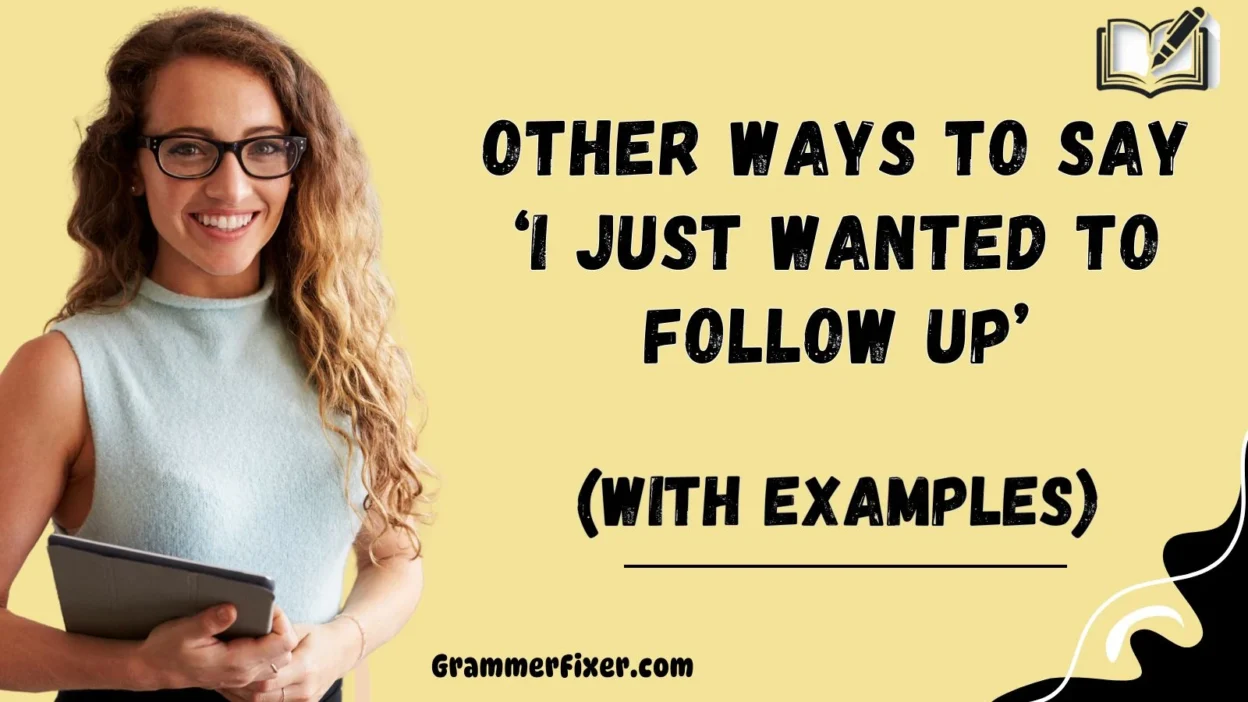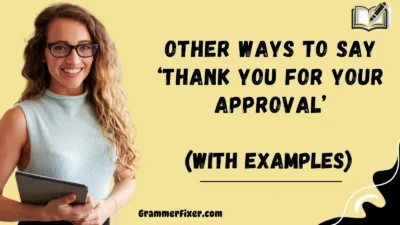In today’s fast-paced professional world, the way you follow up can make all the difference between sounding genuinely considerate and coming across as impatient or pushy. Choosing the right words helps you express care, professionalism, and respect for someone’s time.
Below, you’ll find 30 warm, polite, and thoughtful alternatives to “I just wanted to follow up,” along with their meanings, tones, examples, and best-use cases.
What Does “I Just Wanted to Follow Up” Mean?
The phrase “I just wanted to follow up” is commonly used in professional communication to check on a previous conversation, request, or pending response. It’s a polite way to remind someone about something without sounding demanding.
However, overusing it or phrasing it too vaguely can sometimes make your message seem repetitive or passive, which is why finding alternatives can help you sound more confident and engaging.
When to Use “I Just Wanted to Follow Up”?
Use this phrase (or its alternatives) when:
- You’ve previously reached out and haven’t received a response.
- You’re checking on a project or application status.
- You’re reconfirming interest or availability after an initial conversation.
- You want to show continued interest politely, without pressure.
Is It Professional/Polite to Say “I Just Wanted to Follow Up”?
Yes—it’s polite and professional, but context and tone matter. If your email is brief, kind, and includes gratitude or understanding, it will always sound professional. However, avoid using it too frequently or too soon, as it might appear impatient.
To make it better, try adding context, such as what you’re following up on and why it matters.
Pros or Cons
Pros:
- Sounds polite and familiar.
- Keeps communication open and respectful.
- Easy to use in almost any context.
Cons:
- Can sound repetitive if overused.
- May appear indirect or hesitant.
- Lacks personalization without context.
1. Checking In Regarding Our Previous Conversation
Meaning: You’re politely reaching out to reconnect on a discussion or pending update.
Detailed Explanation: This phrase adds clarity and purpose to your follow-up, showing that you’re not just sending a generic reminder.
Example:
“Hi Sarah, I’m checking in regarding our previous conversation about the project proposal.”
Best Use: When following up on an earlier email or meeting.
Worst Use: When no prior conversation occurred.
Why It Works: It’s direct, polite, and context-aware.
Tone: Professional and respectful.
2. I Wanted to Touch Base
Meaning: A warm, conversational way to reconnect or get an update.
Detailed Explanation: This phrase creates a friendly tone that fits both internal and external communication.
Example:
“Hi Mark, I wanted to touch base about the next steps for the marketing campaign.”
Best Use: For casual check-ins with colleagues or clients.
Worst Use: In very formal or executive-level emails.
Why It Works: Sounds approachable and engaging.
Tone: Conversational and cooperative.
3. Following Up on My Last Email
Meaning: You’re politely referring to a specific email without sounding pushy.
Detailed Explanation: It’s short and professional but adds accountability by referencing your prior message.
Example:
“Hi Emily, following up on my last email about the design approval.”
Best Use: When referencing a clearly dated previous message.
Worst Use: When you haven’t sent anything before.
Why It Works: It’s concise and factual.
Tone: Neutral and professional.
4. Wanted to See If You Had a Chance to Review
Meaning: This phrase is ideal when someone owes you feedback or approval.
Detailed Explanation: It softens your request while maintaining clarity about your intent.
Example:
“Hi Alex, I wanted to see if you had a chance to review the attached proposal.”
Best Use: When awaiting feedback on documents or suggestions.
Worst Use: For unrelated updates or introductions.
Why It Works: Shows patience and professionalism.
Tone: Gentle and considerate.
5. I Hope This Finds You Well — Following Up on…
Meaning: A warm, polished way to follow up while showing care.
Detailed Explanation: Combining a greeting with your follow-up adds a personal touch to your message.
Example:
“Hi Olivia, I hope this finds you well. I’m following up on our previous discussion about scheduling a call.”
Best Use: When emailing clients, new contacts, or recruiters.
Worst Use: When you’ve already used the phrase multiple times in the same thread.
Why It Works: Balances warmth with professionalism.
Tone: Friendly and courteous.
6. Circling Back on Our Conversation
Meaning: A professional yet approachable way to revisit a topic.
Detailed Explanation: “Circling back” implies continued engagement and interest without urgency.
Example:
“Hi Jason, just circling back on our conversation about the new pricing model.”
Best Use: When revisiting ongoing discussions.
Worst Use: For new outreach or cold emails.
Why It Works: Feels natural and proactive.
Tone: Polished and engaging.
7. Checking to See If There’s Any Update
Meaning: A polite nudge for progress or news.
Detailed Explanation: Great for ongoing projects or job applications.
Example:
“Hi Lisa, checking to see if there’s any update on my application status.”
Best Use: When waiting for responses that may take time.
Worst Use: Too soon after your last email.
Why It Works: It’s courteous yet clear.
Tone: Neutral and professional.
8. Wanted to Reconnect on This
Meaning: Perfect for re-establishing communication after a pause.
Detailed Explanation: Implies interest without pressure, keeping the tone light.
Example:
“Hi Tom, I wanted to reconnect on this to see if there’s anything further needed from my side.”
Best Use: For paused or delayed discussions.
Worst Use: When the topic was already closed.
Why It Works: Feels friendly and thoughtful.
Tone: Warm and professional.
9. Just Reaching Out Again
Meaning: A gentle reminder of your previous outreach.
Detailed Explanation: It’s humble yet persistent, suitable when you don’t want to sound pushy.
Example:
“Hi Anna, just reaching out again to follow up on our earlier chat.”
Best Use: For repeated follow-ups after no reply.
Worst Use: When urgency is needed.
Why It Works: Keeps things polite and non-demanding.
Tone: Kind and soft.
10. I Wanted to Make Sure My Previous Message Reached You
Meaning: A non-confrontational way to confirm receipt.
Detailed Explanation: Helps you check in without implying fault.
Example:
“Hi Paul, I wanted to make sure my previous message reached you.”
Best Use: When unsure if the email was received.
Worst Use: If they’ve already responded.
Why It Works: It’s empathetic and understanding.
Tone: Gentle and polite.
11. Following Up to See If You Had Any Thoughts
Meaning: Invites feedback rather than demanding it.
Detailed Explanation: Encourages collaboration by keeping the tone open.
Example:
“Hi Jennifer, following up to see if you had any thoughts on my proposal.”
Best Use: For projects or idea submissions.
Worst Use: For deadline reminders.
Why It Works: Encourages engagement.
Tone: Thoughtful and inclusive.
12. I Wanted to Follow Up and See How Things Are Progressing
Meaning: Shows ongoing interest in shared projects.
Detailed Explanation: Ideal for team communication or project management.
Example:
“Hi Chris, I wanted to follow up and see how things are progressing on your end.”
Best Use: For ongoing collaborations.
Worst Use: For short, single exchanges.
Why It Works: Feels cooperative.
Tone: Professional and supportive.
13. Touching Base to Check on the Next Steps
Meaning: A friendly way to seek clarification on future actions.
Detailed Explanation: Keeps momentum while respecting the other person’s timeline.
Example:
“Hi Mia, touching base to check on the next steps for our partnership.”
Best Use: For business follow-ups or partnerships.
Worst Use: When no next step exists.
Why It Works: Signals initiative.
Tone: Warm and proactive.
14. Following Up to Confirm Receipt
Meaning: You’re confirming they received your earlier message.
Detailed Explanation: Adds professionalism while maintaining patience.
Example:
“Hi Kevin, following up to confirm receipt of my previous email regarding the invoice.”
Best Use: When awaiting acknowledgment or payment confirmation.
Worst Use: For general updates.
Why It Works: Shows reliability.
Tone: Formal and courteous.
15. Checking Whether You’ve Had a Chance to Look Into This
Meaning: Encourages response without pressure.
Detailed Explanation: It’s conversational but clear in purpose.
Example:
“Hi Rachel, checking whether you’ve had a chance to look into this request.”
Best Use: When waiting for someone’s input.
Worst Use: After multiple reminders.
Why It Works: Sounds understanding.
Tone: Polite and composed.
16. I Wanted to See If There’s Been Any Progress
Meaning: You’re gently asking for an update on something in progress.
Detailed Explanation: This phrasing shows interest and involvement, while being tactful and non-demanding.
Example:
“Hi Emma, I wanted to see if there’s been any progress on the budget review.”
Best Use: For ongoing projects or pending updates.
Worst Use: When the recipient has already shared a timeline.
Why It Works: Demonstrates initiative and professionalism.
Tone: Curious, respectful, and polite.
17. I’d Love to Hear Back When You Have a Moment
Meaning: You’re signaling patience while inviting a reply.
Detailed Explanation: This phrase shows understanding of the recipient’s busy schedule, maintaining a warm, courteous tone.
Example:
“Hi Jordan, I’d love to hear back when you have a moment about the client feedback.”
Best Use: For gentle reminders to colleagues or clients.
Worst Use: When urgency is required.
Why It Works: Sounds human and empathetic.
Tone: Warm and understanding.
18. I Wanted to Revisit Our Previous Discussion
Meaning: You’re bringing attention back to an earlier topic or proposal.
Detailed Explanation: “Revisit” implies continuity and professionalism without any sense of pressure.
Example:
“Hi Sophie, I wanted to revisit our previous discussion about the training session schedule.”
Best Use: When restarting paused discussions or proposals.
Worst Use: When no prior discussion exists.
Why It Works: Conveys consistency and reliability.
Tone: Professional and collaborative.
19. Just Following Up to Ensure Everything Is on Track
Meaning: A proactive way to check progress while expressing support.
Detailed Explanation: It balances accountability and teamwork, especially in team or project contexts.
Example:
“Hi Daniel, just following up to ensure everything is on track for Monday’s presentation.”
Best Use: For internal team communications.
Worst Use: For external follow-ups where you’re not directly involved.
Why It Works: Encourages productivity and cooperation.
Tone: Supportive and professional.
20. I Wanted to Touch Base Before the Deadline
Meaning: A proactive check-in before a due date or milestone.
Detailed Explanation: It shows responsibility and foresight, signaling that you care about timeliness.
Example:
“Hi Lily, I wanted to touch base before the deadline to confirm everything’s in order.”
Best Use: For time-sensitive projects or deliverables.
Worst Use: After the deadline has passed.
Why It Works: Demonstrates accountability and initiative.
Tone: Responsible and considerate.
21. I Hope You’re Doing Well — Any Updates on This?
Meaning: Combines warmth with a polite request for updates.
Detailed Explanation: This structure makes your follow-up feel personal and friendly, not transactional.
Example:
“Hi Robert, I hope you’re doing well. Any updates on the contract review?”
Best Use: For ongoing professional relationships.
Worst Use: For very formal or first-time contacts.
Why It Works: Builds rapport while maintaining professionalism.
Tone: Friendly and approachable.
22. I Wanted to See If You Needed Anything Else From Me
Meaning: You’re offering support instead of just seeking information.
Detailed Explanation: This phrasing shifts the focus to helpfulness, making your email feel service-oriented.
Example:
“Hi Ella, I wanted to see if you needed anything else from me to move forward.”
Best Use: When working collaboratively on tasks or approvals.
Worst Use: When you’re the one expecting a response.
Why It Works: Creates goodwill and professionalism.
Tone: Helpful and thoughtful.
23. I Wanted to Make Sure Everything’s Clear
Meaning: You’re confirming understanding or next steps.
Detailed Explanation: Ideal for ensuring communication hasn’t been misunderstood or lost in translation.
Example:
“Hi Peter, I wanted to make sure everything’s clear regarding tomorrow’s presentation.”
Best Use: After giving instructions or proposals.
Worst Use: When it might sound like you’re questioning someone’s comprehension.
Why It Works: Encourages open communication.
Tone: Clear and supportive.
24. Following Up to See If You’d Like to Proceed
Meaning: Gently asks for a decision or next step.
Detailed Explanation: Works perfectly in sales, project, or client contexts when awaiting approval or confirmation.
Example:
“Hi Maya, following up to see if you’d like to proceed with the service agreement.”
Best Use: For closing or progressing deals.
Worst Use: For non-transactional updates.
Why It Works: Keeps the tone action-oriented and polite.
Tone: Polished and persuasive.
25. Just Wanted to Check Whether You’re Still Interested
Meaning: Politely verifies if the recipient remains engaged.
Detailed Explanation: Prevents wasted effort while maintaining courtesy.
Example:
“Hi David, just wanted to check whether you’re still interested in the upcoming collaboration.”
Best Use: When follow-ups go unanswered for a while.
Worst Use: For active conversations.
Why It Works: Balances professionalism with clarity.
Tone: Neutral and respectful.
26. I Wanted to Make Sure I Didn’t Miss Your Response
Meaning: A humble, non-confrontational follow-up.
Detailed Explanation: Puts the responsibility on yourself, which softens the tone.
Example:
“Hi Sophia, I wanted to make sure I didn’t miss your response regarding the proposal.”
Best Use: After a reasonable waiting period.
Worst Use: If they’ve clearly seen or acknowledged your message.
Why It Works: Sounds polite and self-aware.
Tone: Gentle and considerate.
27. I Wanted to Follow Up Before Wrapping Up My Week
Meaning: Casual yet structured, showing time awareness.
Detailed Explanation: Ideal for Friday emails, showing you’re being proactive before the weekend.
Example:
“Hi Ben, I wanted to follow up before wrapping up my week on the training schedule.”
Best Use: End-of-week communications.
Worst Use: For urgent weekday matters.
Why It Works: Feels timely and responsible.
Tone: Friendly and relaxed.
28. I’m Checking In to See If You Need Any Further Information
Meaning: You’re politely offering assistance to move things along.
Detailed Explanation: This phrasing turns your follow-up into a helpful gesture rather than a request.
Example:
“Hi Natalie, I’m checking in to see if you need any further information to finalize the decision.”
Best Use: When you’ve previously provided resources or proposals.
Worst Use: When asking for unrelated updates.
Why It Works: Keeps tone generous and helpful.
Tone: Supportive and professional.
29. I Wanted to Reach Out About My Previous Email
Meaning: A classic, respectful reminder referencing earlier communication.
Detailed Explanation: Keeps your follow-up short, factual, and polite.
Example:
“Hi James, I wanted to reach out about my previous email regarding the budget review.”
Best Use: General, low-pressure follow-ups.
Worst Use: Multiple follow-ups in quick succession.
Why It Works: Simple and widely accepted.
Tone: Neutral and formal.
30. I Wanted to Follow Up and Keep Things Moving Forward
Meaning: You’re expressing initiative and teamwork.
Detailed Explanation: This phrase conveys momentum and professionalism, ideal for leaders or coordinators.
Example:
“Hi Claire, I wanted to follow up and keep things moving forward with the final deliverables.”
Best Use: For project management and leadership communication.
Worst Use: For casual check-ins.
Why It Works: Sounds proactive and confident.
Tone: Motivating and professional.
Conclusion
Choosing the right follow-up phrase isn’t just about words—it’s about tone, timing, and intent. The way you follow up reflects your professionalism, empathy, and respect for others’ time. By using alternatives that sound thoughtful, clear, and genuine, you strengthen relationships, improve communication, and leave a lasting positive impression.
Whether you say “I wanted to touch base” or “Just checking in regarding our previous conversation,” the goal remains the same: to connect with care and purpose.



